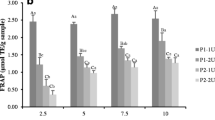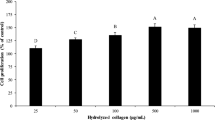Abstract
Fish skin collagen hydrolysates (FSCH) were prepared from walleye pollock (Theragra chalcogramma) using a mixture of enzymes, namely trypsin and flavourzyme. The degree of hydrolysis of the skin collagen was 27.3%. FSCH was mainly composed of low-molecular-weight peptides and the relative proportion of <1000Da fraction was 70.6%. Free radical and oxygen species scavenging activities of FSCH were investigated in four model systems, including diphenylpicrylhy-drazyl radical (DPPH), superoxide anion radical, hydroxyl radical and hydrogen peroxide model, and compared with that of a native antioxidant, reduced glutathione (GSH). FSCH was also evaluated by water-absorbing and water-holding capacity. The results showed that FSCH was able to scavenge free radical and oxygen species significantly and to enhance water-absorbing and water-holding capacity remarkably. Therefore, FSCH may have potential applications in the medicine and food industries.
Similar content being viewed by others
References
Cheng, Y. H., Wang, Z., and Xu, S. Y., 2006. Antioxidant properties of wheat germ protein hydrolysates evaluated in vitro. J. Cent. South Unit. Technol., 13: 160–165.
Dong, S. Y., Zeng, M. Y., Wang, D. F., Liu, Z. Y., Zhao, Y. H., and Yang, H. C., 2007. Antioxidant and biochemical properties of protein hydrolysates prepared from Silver carp (Hypophthalmichthys molitrix). Food Chem., 14: 1485–1493.
Jun, S. Y., Park, P. J., Jung, W. K., and Kim, S. K., 2004. Purification and characterization of an antioxidative peptide from enzymatic hydrolysate of yellowfin sole (Limanda aspera) frame protein. Eur. Food Res. Technol., 219: 20–26.
Kanatt, S. R., Chander, R., and Sharma, A., 2007. Antioxidant potential of mint (Menthaspicata L.) in radiation processed lamb meat. Food Chem., 100: 451–458.
Kim, S. Y., Je, J. Y., and Kim, S. K., 2007. Purification and characterization of antioxidant peptide from hoki (Johnius belengerii) frame protein by gastrointestinal digestion. J. Nutr. Biochem., 18: 31–38.
Kim, S. K., Kim, Y. T., Byun, H. G., Nam, K. S., Joo, D. S., and Shahidi, F., 2001. Isolation and characterization of antioxidative peptides from gelatin hydrolysate of Alaska Pollack skin. J. Agric. Food Chem., 49: 1984–1989.
Klompong, V., Benjakul, S., Kantachote, D., and Shahidi, F., 2007. Antioxidative activity and functional propertiegrees of protein hydrolysate of yellow stripe trevally (Selaroides leptolepis) as influenced by the de of hydrolysis and enzyme type. Food Chem., 102: 1317–1327.
Kunio, S., Hiroyuki, U., and Hirotomo, O., 2000. Isolation and characterization of free radical scavenging activities peptides derived from casein. J. Nutr. Biochem., 11: 128–131.
Li, B., Chen, F., Wang, X., Ji, B., and Wu, Y., 2007. Isolation and identification of antioxidative peptides from porcine collagen hydrolysate by consecutive chromatography and eletrospray ionization-mass spectrometry. Food Chem., 102: 1135–1143.
Lin, L., and Li, B. F., 2006. Radical scavenging properties of protein hydrolysates from jumbo flying squid (Dosidicus eschrichitii Steenstrup) skin gelatin. J. Sci. Food Agric., 8: 2290–2295.
Moure, A., Domnguez, H., and Parajo, J. C., 2006. Antioxidant properties of ultraltration recovered soy protein fractions from industrial effluents and their hydrolysates. Process Biochem., 41: 447–456.
Nichole, C., Ying, Z., Marian, N., and Fereidoon, S., 2008. Antioxidant activity and water-holding capacity of canola protein hydrolysates. Food Chem., 109: 144–148.
Rajapakse, N., Mendis, E., Byun, H. G., and Kim S. K., 2005. Purification and in vitro antioxidant effects of giant squid muscle peptides on free radical-mediated oxidative systems. J. Nutr. Biochem., 16: 562–569.
Ruch, R. J., Chta, T., and Decker, E. A., 1989. Prevention of cytotoxicity and inhibition of intracellular communication by antioxidant catechins isolated from Chinese green tea. Carcinogenests, 10: 1003–1008.
Sathivel, S., Bechtel, P. J., Babbitt, J., Smiley, S., Crapo, C., and Reppond, K. D., 2003. Biochemical and functional properties of herring (Clupea harengus) byproduct hydrolysates. J. Food Sci., 68: 2196–2200.
Saiga, A., Tanabe, S., and Nishimura, T., 2003. Antioxidant activity of peptides obtained from porcine myobrillar proteins by protease treatment. J. Agric. Food Chem., 51: 3661–3667.
Sakai, Y., 2004. Biological function of a skin-permeable collagen tripeptide (CTP) with glycine at the N-terminus. J. Soc. Photogr. Sci. Technol. Jpn., 67: 397–401 (in Japanese with English abstract).
Shuichi, M., and Hanching, C., 1989. Synthesis and water uptake and holding capacity of chitin and chitosan derivatives. Oil Chem., 38: 492–500.
Shimada, K., Fujikawa, K., Yahara, K., and Nakamura, T., 1992. Antioxidative properties of xanthium on the autoxidation of soybean oil in cyclodextrin emulsion. J. Agric. Food Chem., 40: 945–948.
Shahidi, F., and Synowiecki, J., 1997. Protein hydrolyzates from seal meat as phosphate alternatives in food processing applications. Food Chem., 60: 29–32.
Suetsuna, K., Ukeda, H., and Ochi, H., 2000. Isolation and characterization of free radical scavenging activity peptides derived from casein. J. Nutr. Biochem., 11: 128–131.
Wang, J. S., Zhao, M. M., Zhao, Q. Z., Yang, B., and Jiang, Y. M., 2007. Characterization of hydrolysates derived from enzymatic hydrolysis of wheat gluten. J. Food Sci., 72: 103-107.
Wang, L. L., and Xiong, Y. L., 2005. Inhibition of lipid oxidation in cooked beef patties by hydrolyzed potato protein is related to its reducing and radical scavenging ability. J. Agric. Food Chem., 53: 9186–9192.
Wu, H. C., Chen, H. M., and Shiau, C. Y., 2003. Free amino acids and peptides as related to antioxidant properties in protein hydrolysates of mackerel (Scomber austriasicus). Food Res. Intern., 36: 949–957.
Wu, J. H., Wang, Z., and Xu, S. Y., 2008. Enzymatic production of bioactive peptides from sericin recovered from silk industry wastewater. Process Biochem., 43: 480–487.
Xie, Z. J., Huang, J. R., Xu, X. M., and Jin, Z. Y., 2008. Antioxidant activity of peptides isolated from alfalfa leaf protein hydrolysate. Food Chem., 111: 370–376.
Yan, M. Y., Li, B. F., Zhao, X., Ren, G. Y., Zhuang, Y. L., Hou, H., et al., 2008. Characterization of acid-soluble collagen from the skin of walleye pollock (Theragra chalcogramma). Food Chem., 107: 1581–1586.
Yu, H. H., and Liu, X. G., 2006. In vitro determination of antioxidant activity of proteins from jellyfish Rhopilema esculentum. Food Chem., 95: 123–130.
Zhang, H. J., Luo, C. X., Zhang, X. S., Song, M. Z., and Jiang, X. P., 2003. Application of collagen protein. Leather Sci. Eng., 13: 37–46.
Zhao, X., Xue, C. H., Li, Z. J., Cai, Y. P., Liu, H. Y., and Qi, H. T., 2004. Antioxidant and hepato protective activities of low molecular weight sulfated polysaccharide from Laminaria japonica. J. Appl. Phys., 16: 111–115.
Zhu, K. X., Zhou, H. M., and Qian, H. F., 2006. Antioxidant and free radical scavenging activities of wheat germ protein hydrolysates (WGPH) prepared with alcalase. Process Biochem., 41: 1296–1302.
Author information
Authors and Affiliations
Corresponding author
Rights and permissions
About this article
Cite this article
Zhuang, Y., Li, B. & Zhao, X. The scavenging of free radical and oxygen species activities and hydration capacity of collagen hydrolysates from walleye pollock (Theragra chalcogramma) skin. J. Ocean Univ. China 8, 171–176 (2009). https://doi.org/10.1007/s11802-009-0171-0
Received:
Revised:
Accepted:
Published:
Issue Date:
DOI: https://doi.org/10.1007/s11802-009-0171-0




